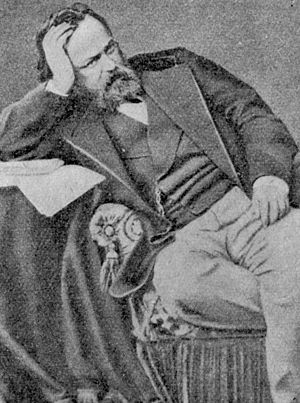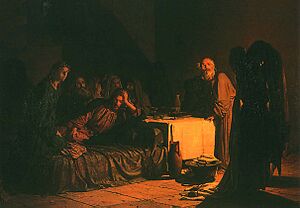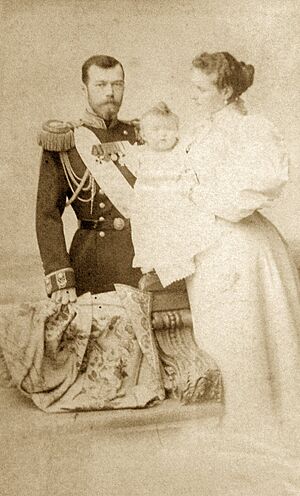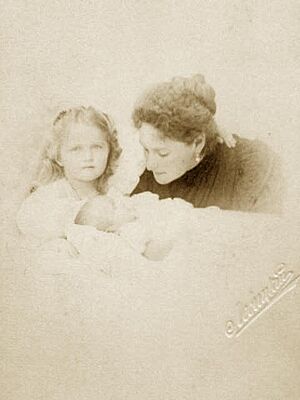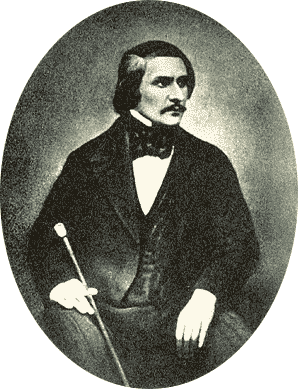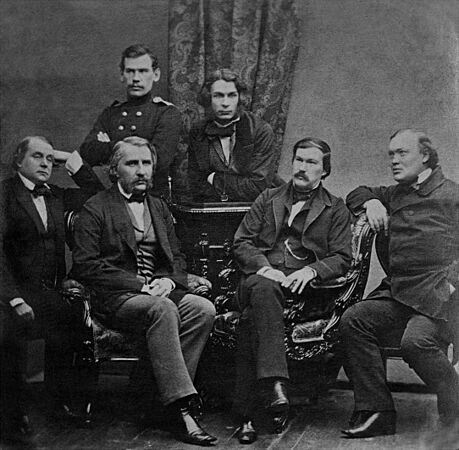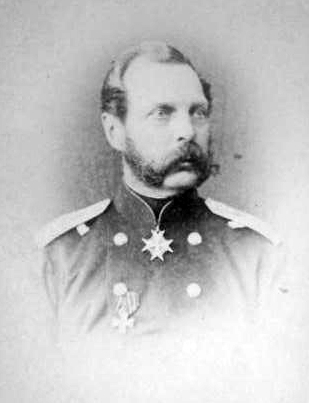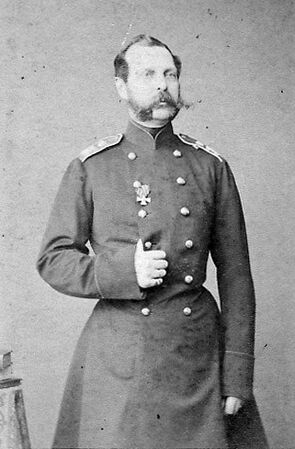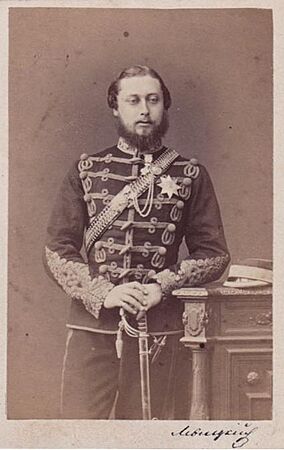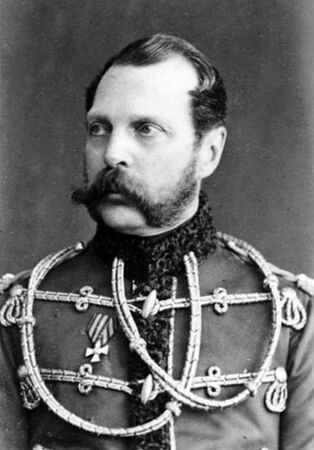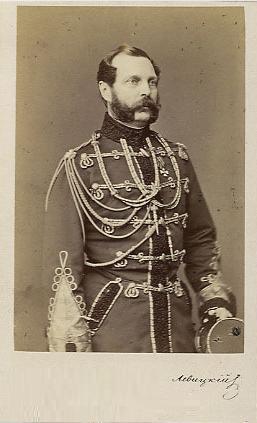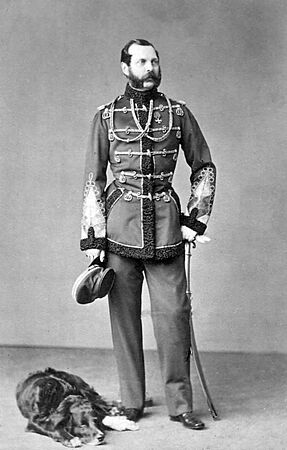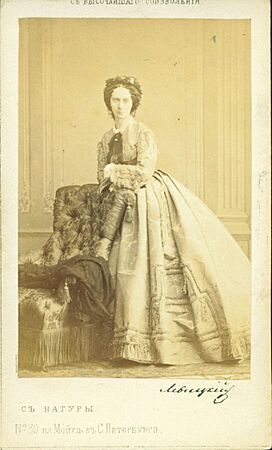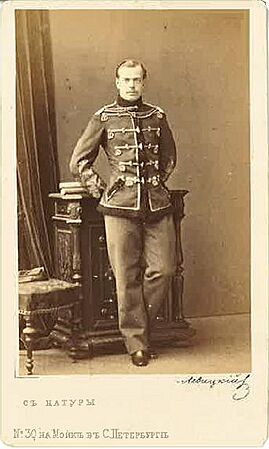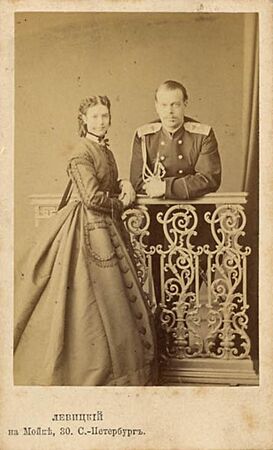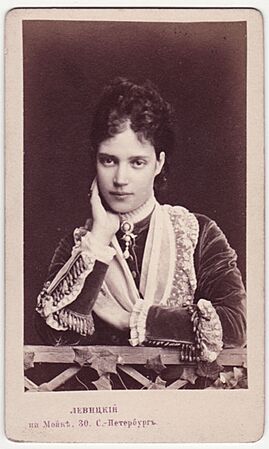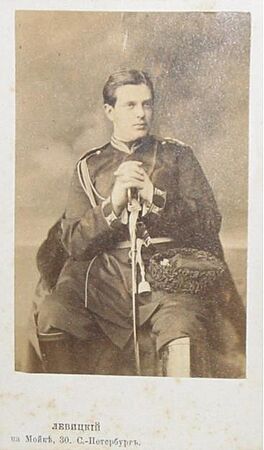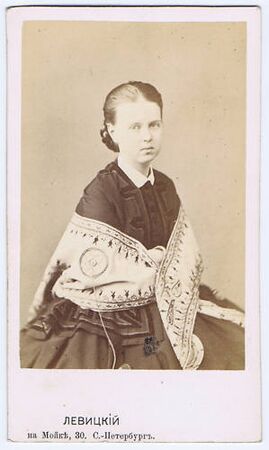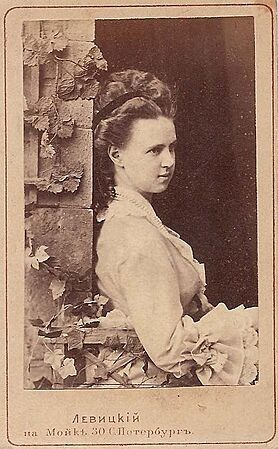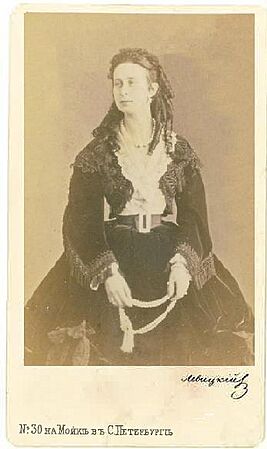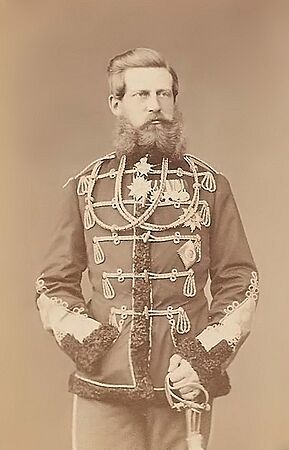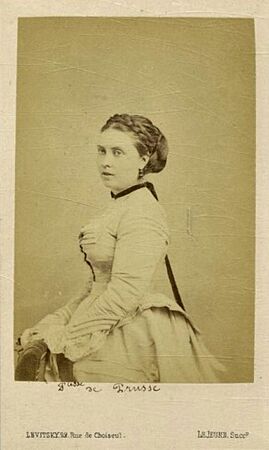Sergey Lvovich Levitsky facts for kids
Quick facts for kids
Sergei Lvovich Levitsky
|
|
|---|---|

Portrait, 1890
|
|
| Born |
Lvov-Lvitsky
1819 |
| Died | 1898 (age 79) |
| Nationality | Russian Empire |
| Education | Faculty of Law, Lomonosov Moscow State University |
| Known for | photographer |
| Movement | Photography |
| Awards | 1849, Paris Exposition of the Second Republic received first ever gold medal for landscape photography; in 1851, received first ever gold medal awarded for portrait photography |
| Patron(s) | Alexander II of Russia, Alexander III of Russia, Nicholas II of Russia, Napoleon III |
Sergei Lvovich Levitsky (Russian: Серге́й Льво́вич Львов-Леви́цкий; born August 17, 1819 – died June 22, 1898) was a very important person in the early days of photography. Many people see him as one of the founders of Russian photography. He was also a leading inventor and innovator in Europe.
Contents
Early Life and Photography Beginnings
Sergei Levitsky came from a noble family. He was a cousin of Aleksandr Ivanovich Herzen, a famous writer. Sergei was also the father of Rafail Sergeevich Levitsky, who became a court photographer for Czar Nicholas II.
Sergei was born in Moscow but later changed his name to Levitsky. He studied law at Lomonosov Moscow State University and worked for the Russian government. Because he spoke several languages, he helped study mineral waters in the Caucasus region.
In 1843, during this trip, Levitsky started taking photos. He used a special camera with a lens from Paris. This was very early in photography, as the first type of photography, called daguerreotype, was invented just a few years earlier in 1839.
Early daguerreotypes needed very long exposure times, sometimes up to thirty minutes for one picture! Levitsky used a new lens that helped make photos much faster. This was a big step forward for photography.
Innovations in Paris
In 1845, Levitsky traveled to Italy and then to Paris, France. He studied physics and chemistry there. Even though he wasn't officially a professional photographer yet, he made big changes in how photos were taken.
He met Louis Daguerre, the inventor of daguerreotype, who was very interested in Levitsky's talent.
In 1847, Levitsky invented a "bellows camera." This camera had a flexible part that helped focus images much better. This idea was so good that it influenced camera designs for many decades. Some professional cameras still use this design today.
While in Paris, Levitsky also started using different backgrounds in his photos. He was also one of the first to touch up negatives. This helped fix any small problems in the pictures.
Levitsky was also the first photographer to show people in different poses in the same photo. For example, someone might appear to be playing the piano and then standing nearby listening to themselves.
In 1849, Levitsky's photos of the Caucasus were shown in Paris. These large photos won a gold medal at the Paris Exposition of the Second Republic. This was the very first time a photography prize like this was ever given out!
Between 1859 and 1864, Levitsky had his own photo studio in Paris. His son, Rafail Levitsky, worked with him there. When his father closed the Paris studio in 1864, Rafail returned to Russia with him.
Levitsky wrote about his time in Paris in a Russian magazine in 1864. He said his studio was so popular that they received about 1500 requests for photos every day! His photos were known all over Europe because he was so good at using both natural and artificial light.
Art and Photography
During his time in Paris, Levitsky became known for creating "psychological photo-portraits." This means his photos didn't just show what someone looked like. They also showed their feelings and personality.
He took a famous photo of his cousin, Alexander Herzen, sitting in a chair. This picture showed Herzen as a deep thinker, looking tired and disappointed. This photo was so powerful that a famous artist, Nikolai Ge, used it as inspiration. Ge used Herzen's pose for the figure of Christ in his painting, The Last Supper (1863).
This was a big moment because it showed how photography could inspire other art forms like painting. It also showed how photography could capture the true spirit of a person.
In 1851, Levitsky won another gold medal at an exhibition in Paris. This time, it was for a portrait photograph. His Paris studio took pictures of many famous people, including U.S. President Millard Fillmore and European royalty. His studio was even given the special title of "court photographer" to Emperor Napoleon III of France.
St. Petersburg Studio
When Sergei Levitsky returned to Russia in 1849, he opened one of the first big photo studios in St. Petersburg. He called it "Light Painting."
Levitsky was the first to suggest using electric lights in a studio along with natural daylight. He thought this would make photography simpler and more practical.
He also traveled to Rome and photographed famous Russian painters and writers, including Nikolai Gogol. Levitsky's portrait of Gogol is now believed to be the only known photo of this important writer. These photos made Levitsky very famous. People were amazed that his studio employees would even travel to customers' homes to take pictures.
The Levitsky studio became known as the best portrait photographers in Russia. They photographed four generations of the Romanov royal family. In 1877, they received the special title "Photographer of their Royal Majesty."
Levitsky is especially famous for his photos of many well-known artists, writers, and public figures. These included Leo Tolstoy, Ivan Turgenev, and Nikolai Nekrasov.
By the 1890s, Sergei's son, Rafail Levitsky, was working closely with his father. Their photo cards from this time often said "Levitsky and Son" on them.
In 1878, Sergei Levitsky helped start Russia's first Photographic Societies. He worked with scientists like Dmitri Ivanovich Mendeleev (who created the periodic table!) to experiment with artificial light in photography.
Sergei Levitsky also wrote articles for a Russian photography magazine. He helped organize many photo exhibitions throughout his life. He even wrote two books about his experiences as a photographer. He passed away in 1898 and was buried in St. Petersburg.
After his father's death, Rafail Levitsky continued the family studio. He took many famous photos of Czar Nicholas II, Empress Alexandra, and their children, including Grand Duchess Olga Nikolaevna of Russia and Alexei Nikolaevich, Tsarevich of Russia. These photos of the Romanovs were so popular that they were sold to the public.
Rafail also started taking photos of everyday Russian actors and people, while still photographing famous Russians like Pyotr Ilyich Tchaikovsky, the famous composer.
The Levitsky studio stayed open until 1918, when it was closed by the Soviet government.
Legacy
For a long time during the Soviet era, the work of Sergei and Rafail Levitsky was not recognized. This was because their family had ties to the royal Romanov family, which was not allowed under the new government.
However, in 1978, the Musée d'Orsay in Paris, France, started collecting Sergei Lvovich Levitsky's work. Soon after, the National Portrait Gallery, London and the Metropolitan Museum of Art in New York also began to show his photos.
In 1992, many old photos were found in the Russian State Documentary Film and Photo Archive. This included many works by Sergei Lvovich Levitsky and Rafail Sergeevich Levitsky.
Today, a large collection of Rafail Sergeevich Levitsky's paintings and many important early photos by Sergei Lvovich Levitsky are kept in The Di Rocco Wieler Private Collection in Toronto, Canada. This collection helps keep their memory and artistic achievements alive.
Selected Works
-
Victoria, Princess Royal, 1870 ('Le Jeune Succ^r')


